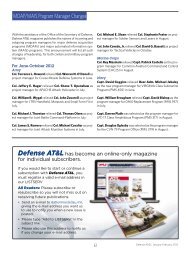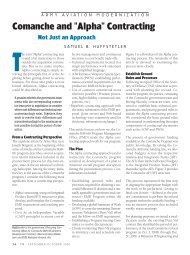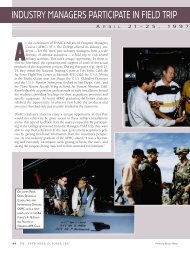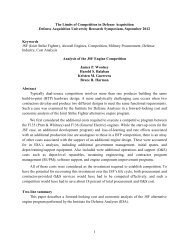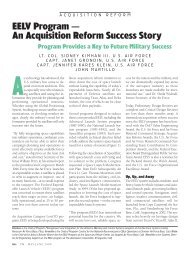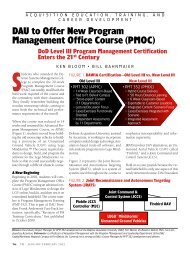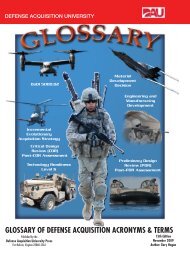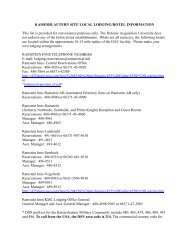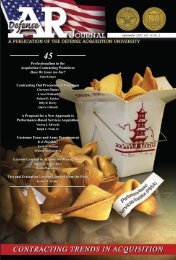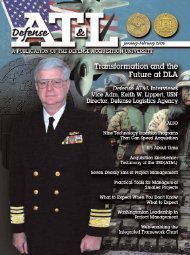Defense ARJ - Defense Acquisition University
Defense ARJ - Defense Acquisition University
Defense ARJ - Defense Acquisition University
You also want an ePaper? Increase the reach of your titles
YUMPU automatically turns print PDFs into web optimized ePapers that Google loves.
<strong>Defense</strong> <strong>Acquisition</strong> Review Journal<br />
new paradigms or shared mental models when dealing with situations of incoherency<br />
and disorderliness) to examine the effectiveness of PPBE in a turbulent world.<br />
In the fifth article, “System of Systems Development for the DoD: Tailoring <strong>Acquisition</strong><br />
Reform for Emerging Needs,” CDR Scott Moran, USN, discusses the challenges<br />
of developing Systems of Systems. When the <strong>Defense</strong> <strong>Acquisition</strong> Performance<br />
Assessment (DAPA) panel proposed sweeping reforms to address long-standing problems<br />
in defense acquisition, their recommendations did not anticipate critical challenges<br />
expected in the development of an SoS. <strong>Defense</strong> leaders counting on revolutionary SoS<br />
capabilities must appreciate that current and proposed acquisition systems insufficiently<br />
facilitate SoS development. This article describes the importance of adapting defense<br />
acquisition processes to enable effective SoS development and concludes with proposed<br />
modifications to the DAPA Report recommendations. Tailoring defense acquisition<br />
organization, budgeting, and requirements generation systems to overcome the challenges<br />
of SoS acquisition will be essential for tomorrow’s military systems to realize<br />
their potential.<br />
In the final article, “A Glimpse into DoD Weapon Systems Programs,” by Andy<br />
Fainer, the author provides a general overview of sustaining Department of <strong>Defense</strong><br />
(DoD) weapon systems as part of the overall defense life cycle management process.<br />
For the past several decades, billions of taxpayer dollars have been spent on weapon<br />
systems annually. The lives of U.S. Armed Forces servicemembers and the people they<br />
protect depend upon the quality and sustainment of these weapon systems. This article<br />
integrates several major themes such as the 2006 Quadrennial <strong>Defense</strong> Review (QDR),<br />
the 2005 National <strong>Defense</strong> Strategy, and logistics transformation (including Future Logistics<br />
Enterprise). The author also summarizes six Government Accountability Office<br />
(GAO) reports in his analysis.<br />
Dr. Paul Alfieri<br />
Executive Editor<br />
<strong>Defense</strong> <strong>ARJ</strong>



